12 Beautiful Desert Landscaping Ideas to Try at Your Home
By Axis Fuksman-Kumpa • December 5, 2023
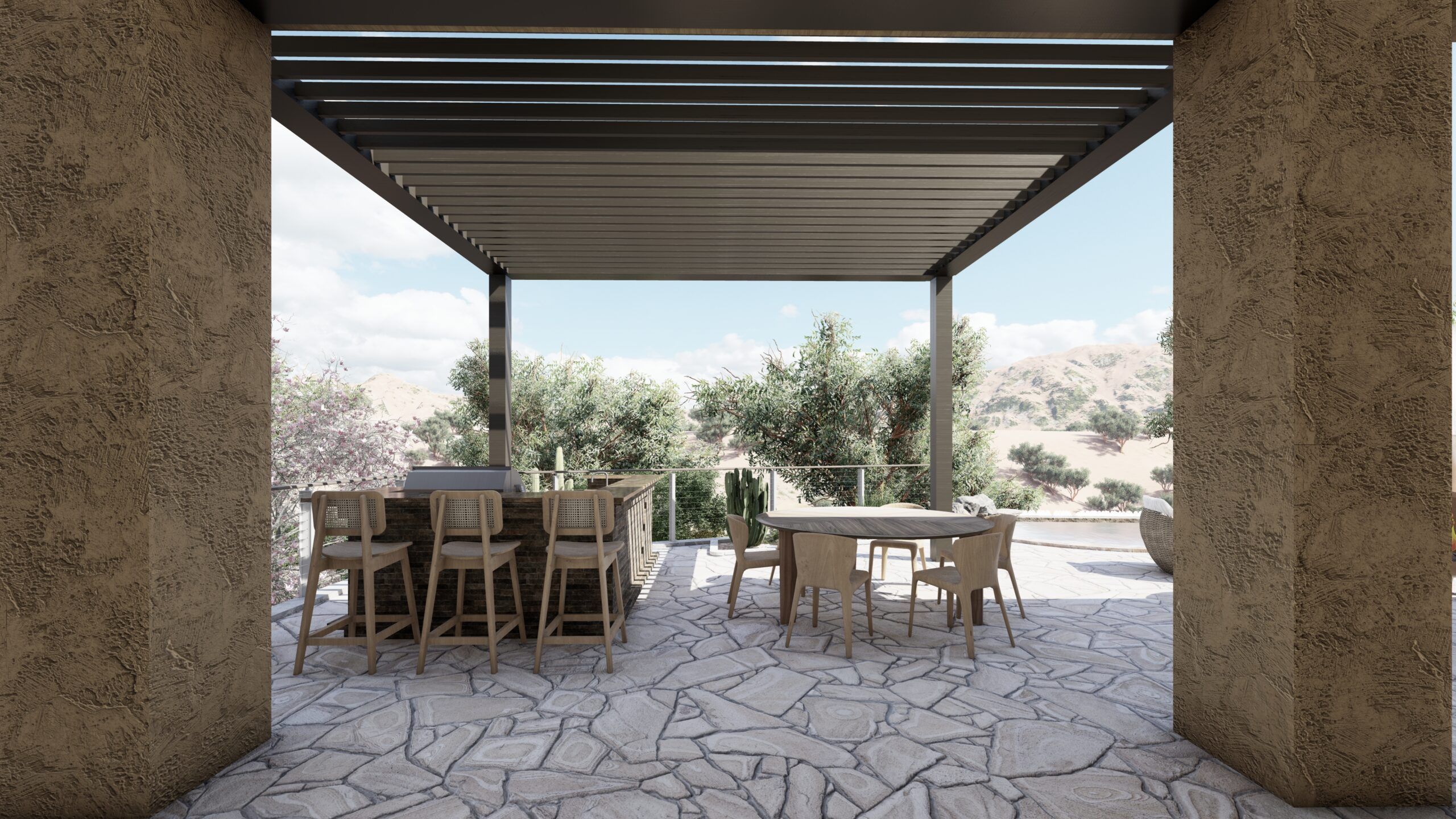
A desert landscape has a wealth of beautiful plants, flowers and hardscape to chose from to create a vibrant design plan. Desert landscaping can beautifully reflect the architectural design of your home and can incorporate sustainable design practices in a very sensible way. Keep reading to find 12 easy desert landscaping ideas we at Tilly like to incorporate in our designs that you can also use when planning your own yard.
Desert Landscape Considerations
Desert climates come with a range of special considerations to keep in mind when landscaping. Between strong sun, extreme heat, infrequent rain, and sandy soil, plants and materials need to be chosen carefully. The key to a successful desert garden is knowing what plants and landscaping features can survive and thrive at your home.
Before you break ground on any renovation, make sure you can answer some important questions, like:
- What is your hardiness zone?
- What kind of soil do you have?
- How much sunlight does your yard get?
- How hot does your region get during the day?
- How cold does it get at night?
- Does your area experience extreme weather conditions?
If you design with this knowledge in mind, your desert landscaping is much more likely to flourish in your unique climate.
#1 // Reduce Your Lawn Space
If there's one thing that typical turf grass wants, it's water, water, and more water. While a sweeping green grass lawn might be the standard for some parts of the country (although we love changing this mindset!), it can be a struggle to get grass to stay alive in desert climates. Minimal water and harsh sun are a recipe for a scraggly brown lawn.
Instead of spending every afternoon watering the grass, we recommend reducing your lawn space to make your backyard more low maintenance and to capture an authentic southwestern feel in your landscape design. There are many grass alternatives you can use to fill that large area of lawn space:
- Switch to a living groundcover that suits your climate, like creeping thyme, creeping mazus, creeping jenny, or dymondia. Some grass alternatives even produce flowers!
- Try artificial turf if you love the look of green grass but don't want to foot the water bill for natural turf.
- Use hardscape groundcover like stone, gravel, sand, patios, and decking to create functional zones in your landscaping.

#2 // Select Drought-Tolerant Desert Plants
If you want plants to survive in your desert garden, we recommend choosing naturally drought-tolerant options. The goal is to select hardy desert plants that are specialized to grow in your desert climate.
One of the simplest ways to find what will work for your area is to choose native plants that you know naturally thrive in your local landscape. Native plants will be hardier, require less watering, and generally be more low maintenance than common garden plants from other regions.
Best of all, you have a wide range of plants to choose from! Desert gardens can be home to a whole range of trees, shrubs, desert wildflowers, succulents, and of course, cacti. Some of our favorite desert plant options include:
- Golden barrel cactus
- Saguaro cactus
- Ornamental grass
- Agave
- Prickly pear cactus
- Russian sage
- Native wildflowers
A palette comprised of native plants and these hardy, drought-tolerant plants will instantly bring the desert landscape back into your backyard.
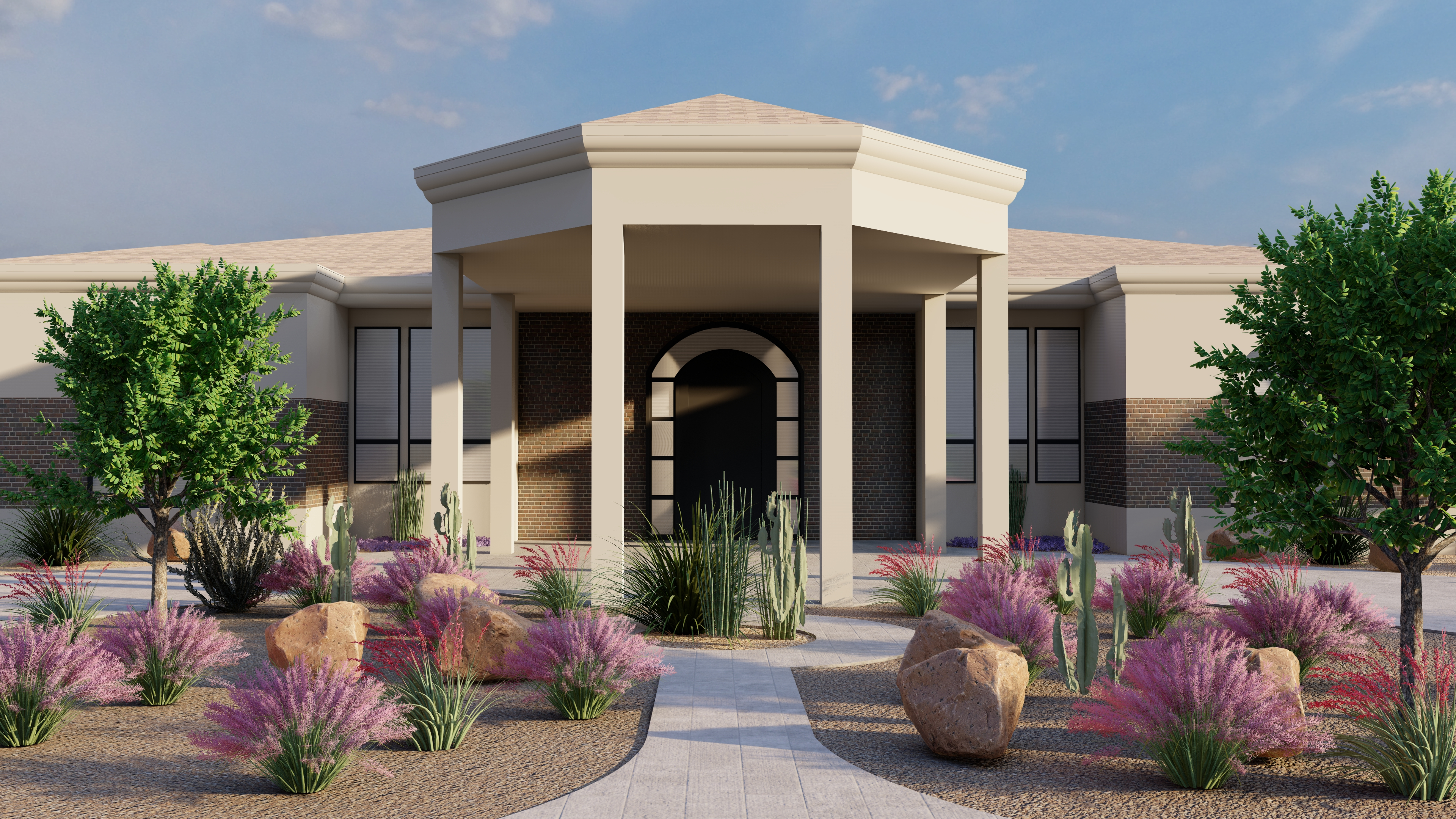
#3 // Know Your Cacti vs. Succulents
Cacti and succulents are often the go-to plants for desert landscaping, so you should get to know them before you fill your cart at the nursery.
A succulent is any plant that can store water in its fleshy stems and thick leaves, allowing it to survive long periods of time without water. Succulents aren't one family of plant—they're a categorization of plant that can be found in nearly 60 plant families around the world. Common succulents include Aloe, Haworthia, Crassula, Echeveria, and Sedum.
A cactus is any member of the plant family Cactaceae. Cacti are a type of succulent which are also specialized to retain moisture in their thick stems. They stand out from other succulent plants thanks to their spines. Most cacti don't produce what we typically think of as leaves, instead producing highly specialized leaves which look like everything from fine hairs to large spikes growing from the plant's areoles. These spines serve as protection from hungry herbivores—and handsy humans.
Make sure to research the care of any cactus or succulent that catches your eye before bringing it home because they all have different care conditions. While some succulents will thrive on the brightest of sunny days, others defy stereotypes and can suffer in too much sunlight.
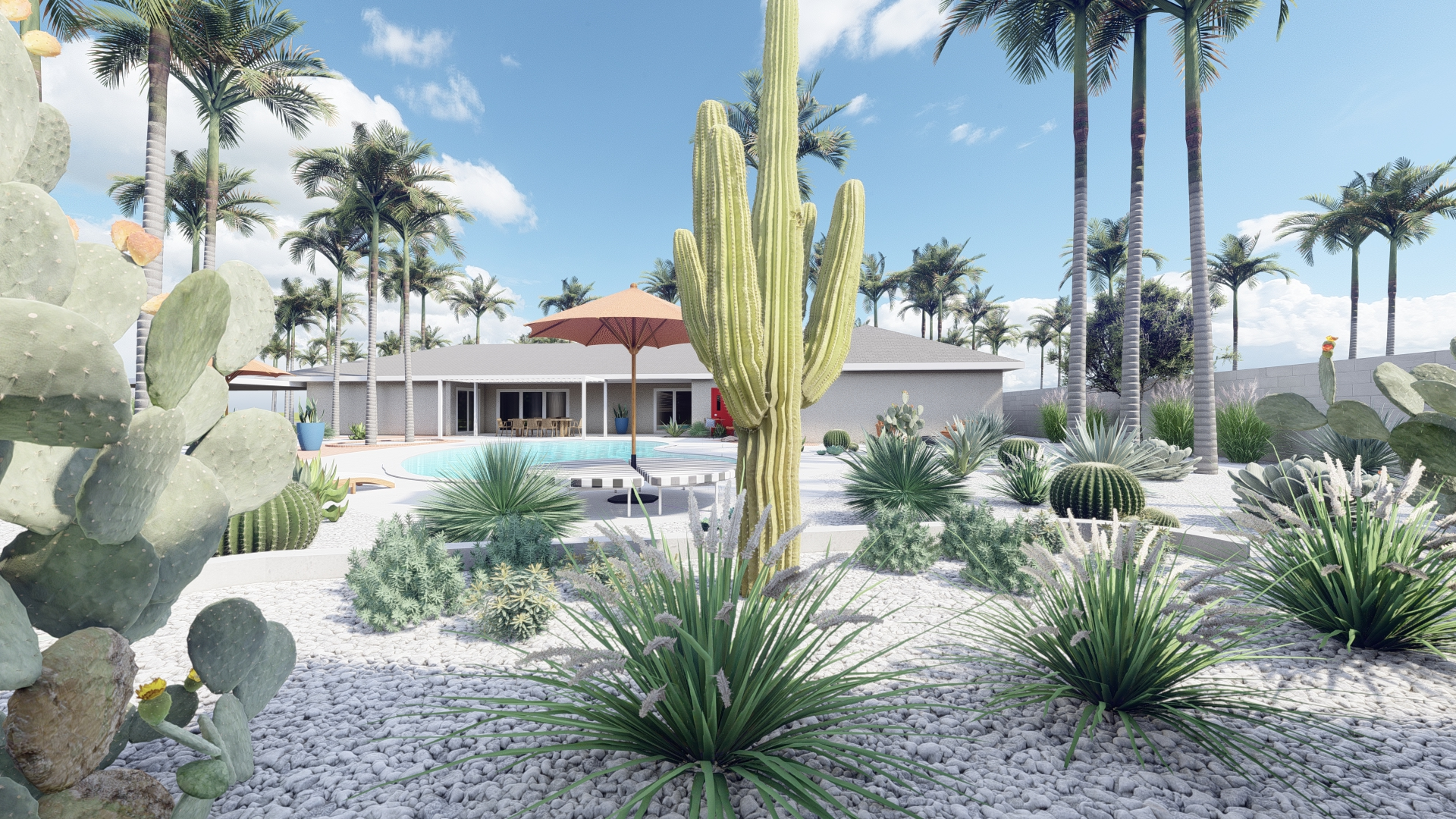
#4 // Use Desert Color Palettes & Textures
To really bring the feeling of the desert and the southwest into your backyard, think about the palette of colors and textures you're using in your design. Creating a cohesive palette and sticking to it throughout your plants, hardscape, furniture, and accessories will help to create a look that is both natural and effortlessly stylish.
When it comes to color, use warm, earthy tones that are naturally found in the desert. Sandy tan and beige, dusty green, and rich terra cotta colors create an easy color palette that is sourced directly from nature. These muted tones provide a perfect backdrop for you to add splashes of color with blooming flowers and vibrant regional art.
There's a rich variety of southwestern patterns to mix and match in your desert landscape for a traditional feel. Reach for painted ceramic tiles, printed rugs, Mexican prints, and woven fabrics that will shine alongside the organic materials in your space. A softer color palette gives you the freedom to mix and match patterns without fear for an eclectic, homey feel.
Simply swapping out accessories can make a big impact on the look of your yard without making a large dent in your wallet. One of the most inexpensive desert landscaping ideas you can find is switching the cushions on your outdoor furniture. Trade in bright or cool colors for a soft beige or off-white textured fabric, and you're well on your way to cultivating a more minimal desert aesthetic.
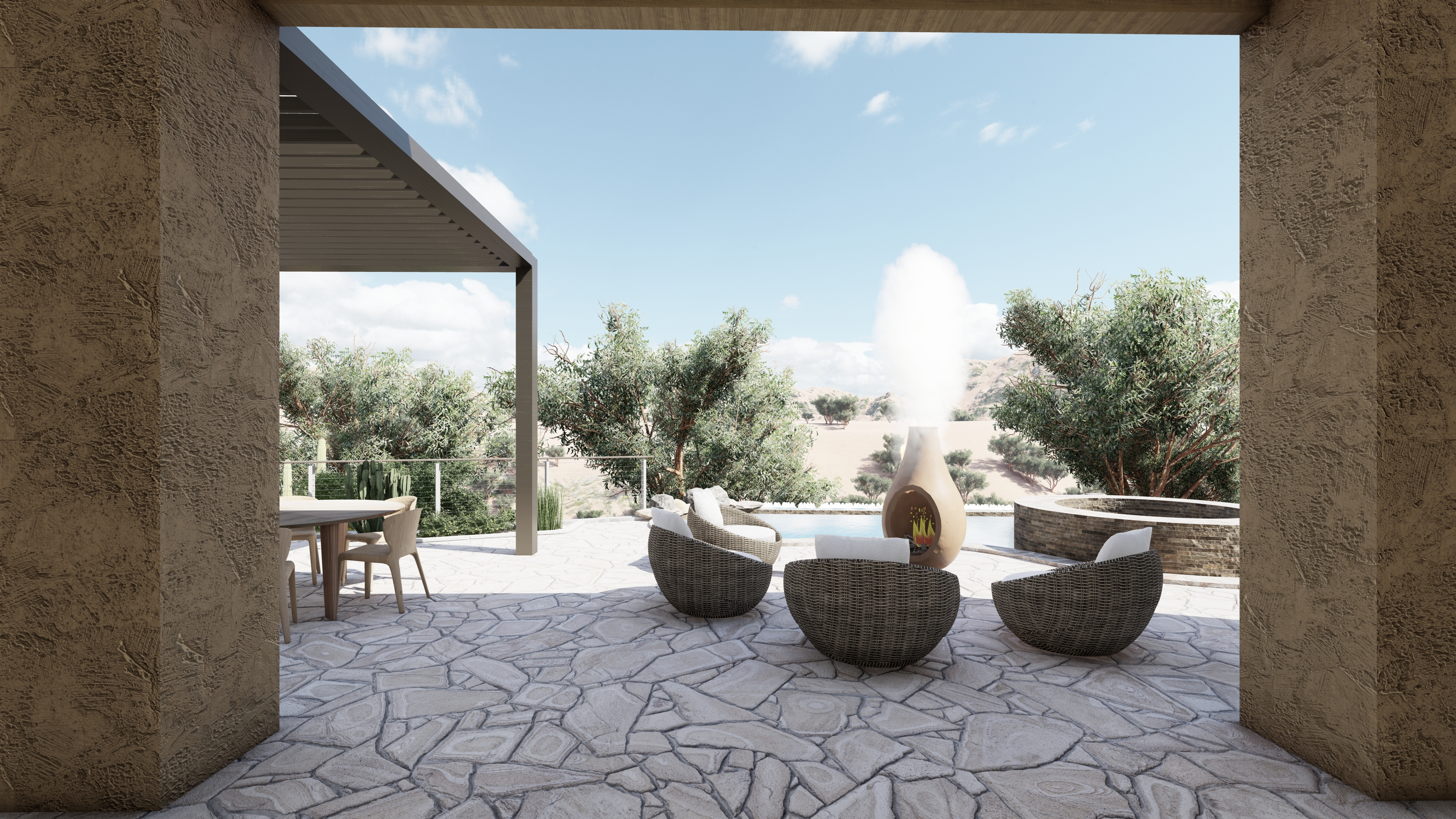
#5 // Opt for Container Gardening
Whether you're combating excessive water usage or dry, rocky soil, container gardening might be just the fix to bring some green into your backyard. Bringing plants up out of the ground soil and into planters where you can more carefully control the moisture and soil content can be a great idea for desert gardens in particular.
Potted plants can be incorporated into your garden with smaller pots of solo plants or larger vessels with an assortment of cohesive flora. Plant your favorite blooming flowers, hardy greenery, small cacti, and succulent plants with similar care requirements together in the same large planter or garden bed to keep maintenance simple. Using terra cotta pots is an easy way to add some southwestern flair.
Raised garden beds are a perfect way to grow some fruits and vegetables in nutritious soil, and careful placement to control how many hours of direct sunlight they get in a day will help to prevent scorched crops. You can make upkeep even simpler by burying an olla pot alongside your produce to keep the soil moist between watering.
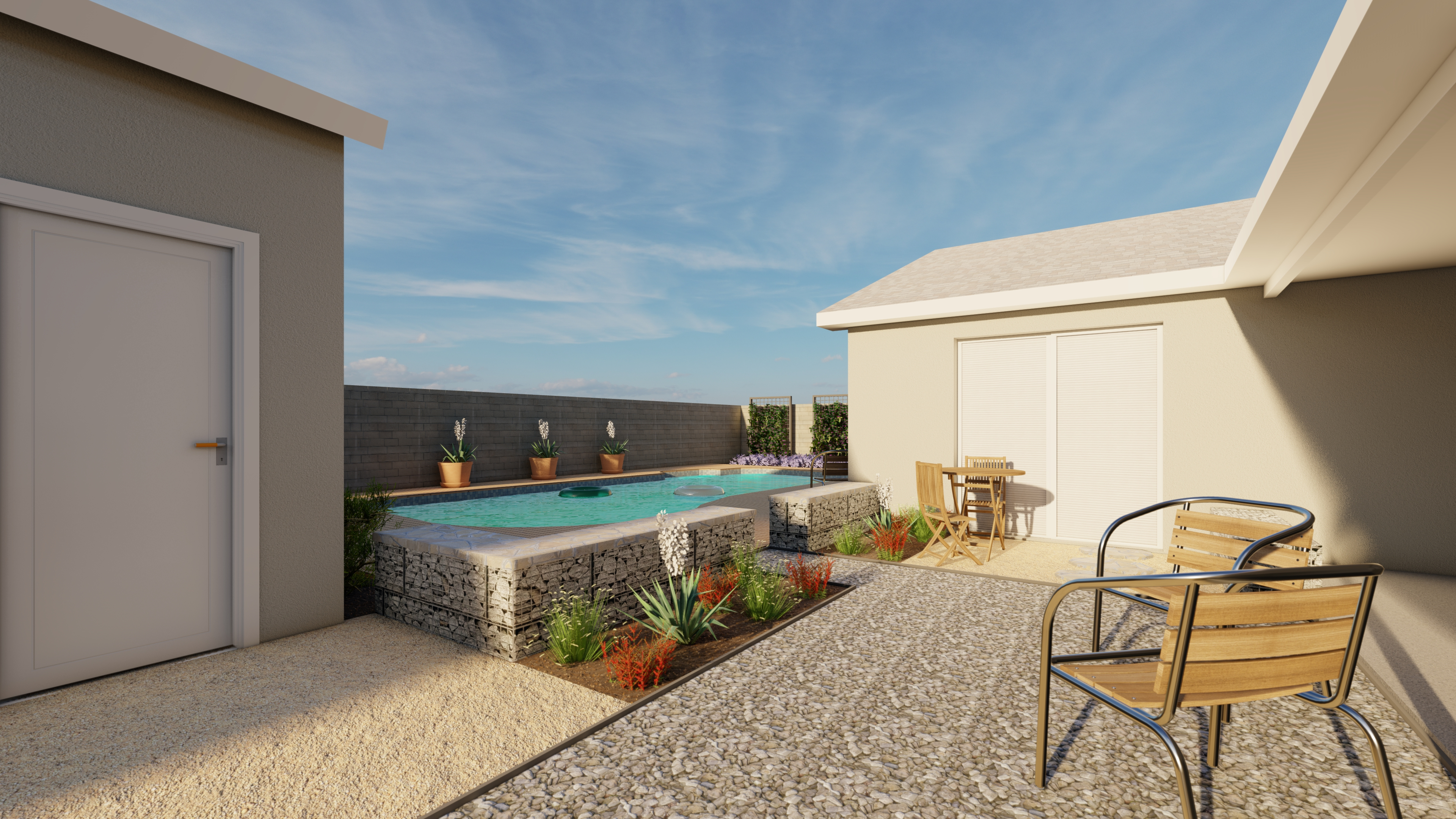
#6 // Add a Cozy Fire Feature
Deserts can get surprisingly cold at night, and adding a fire to your backyard is an ideal desert landscaping idea to keep it welcoming into the evening hours. You have a range of options when it comes to selecting the perfect fire feature for your space.
A dramatic outdoor fireplace can become a backyard centerpiece, while a small moveable fire pit is great for anyone looking for easy, inexpensive desert landscaping ideas. A fire pit table is one of our favorite backyard features, offering functional 24/7 coffee table space around a fire that can be lit whenever you're looking for ambiance (and warmth, of course).
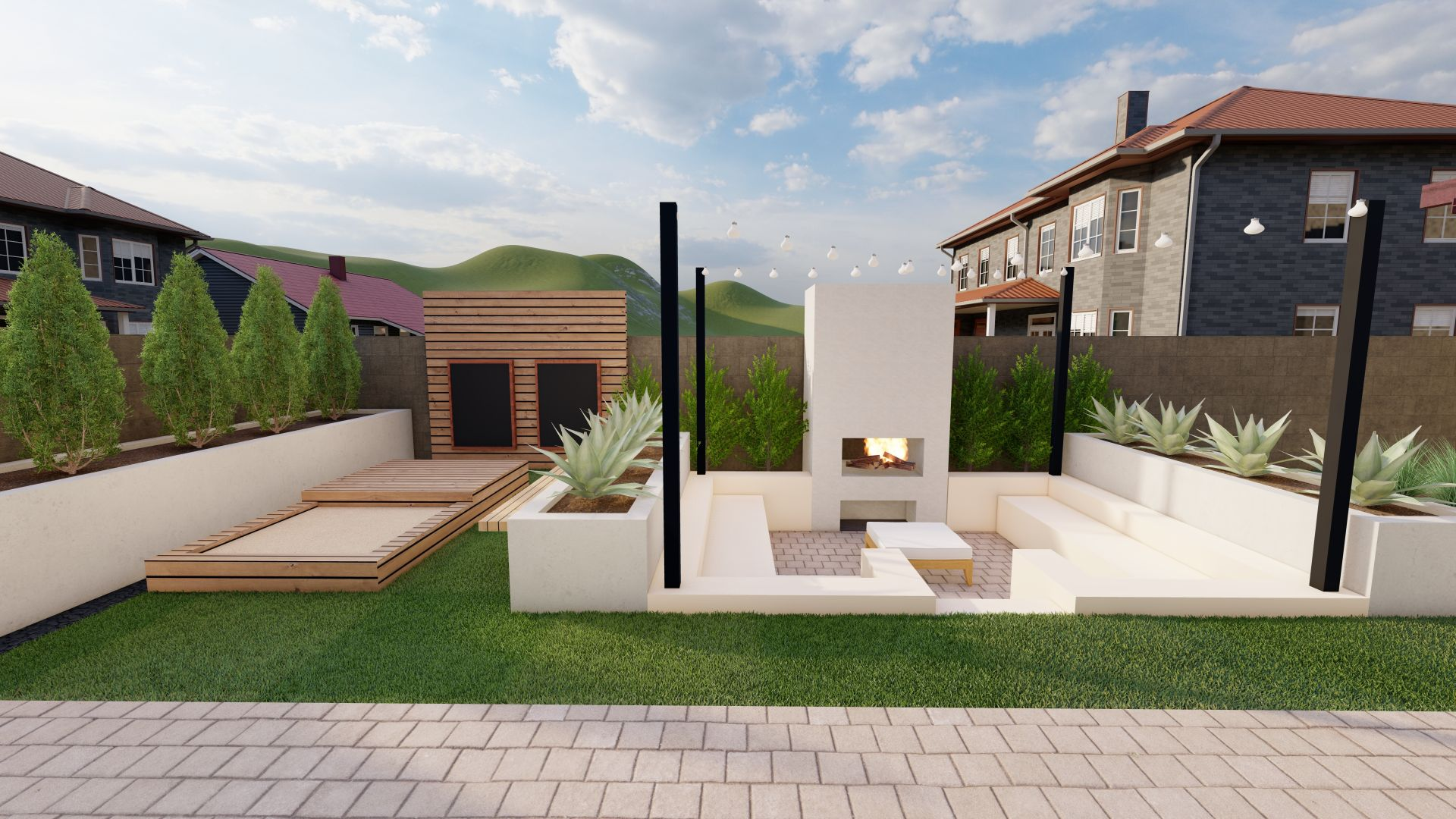
#7 // Use Natural Materials
To truly capture the feeling of nature in your desert landscaping, take advantage of natural materials for your hardscape features. In particular, look for materials that will work in your environment to find landscaping additions that are just as durable as they are visually appealing.
When it comes to furniture, teak wood and wicker can endure the heat without any issues and add soft texture to your outdoor dining area. Pathways, patios, and garden walls made from natural stone will look like a cohesive part of the landscape—particularly if you source local stone. Corten steel is a highly durable material option for planters, edging, and more that brings a rich, rust hue into your desert color palette.
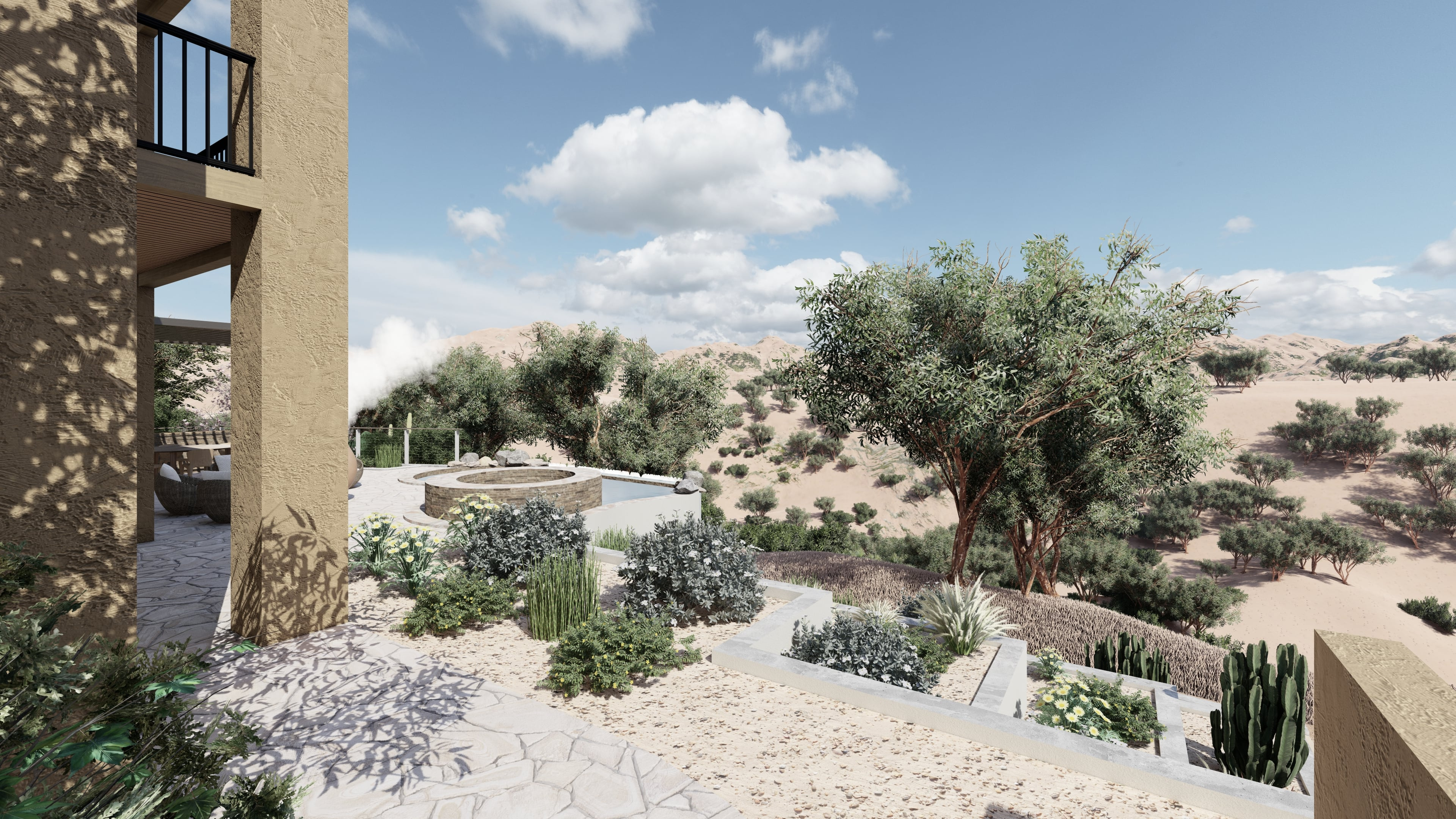
#8 // Paint an Accent Wall
Looking for the perfect backyard focal point for your desert landscaping? We love incorporating an accent wall into our desert designs for a splash of color and added texture. A solid color from your desert color palette like a rusty orange or sage green can draw the eye without being obtrusive, while a more detailed mural adds texture and artistic appeal to the space.
You can easily DIY an accent wall on any fence or stucco garden wall with nothing more than a can of outdoor paint and a couple of brushes or paint rollers. If you're trying to create a more intricate design, you can freehand an abstract mural or opt for a stenciled pattern to help keep everything neat and precise.
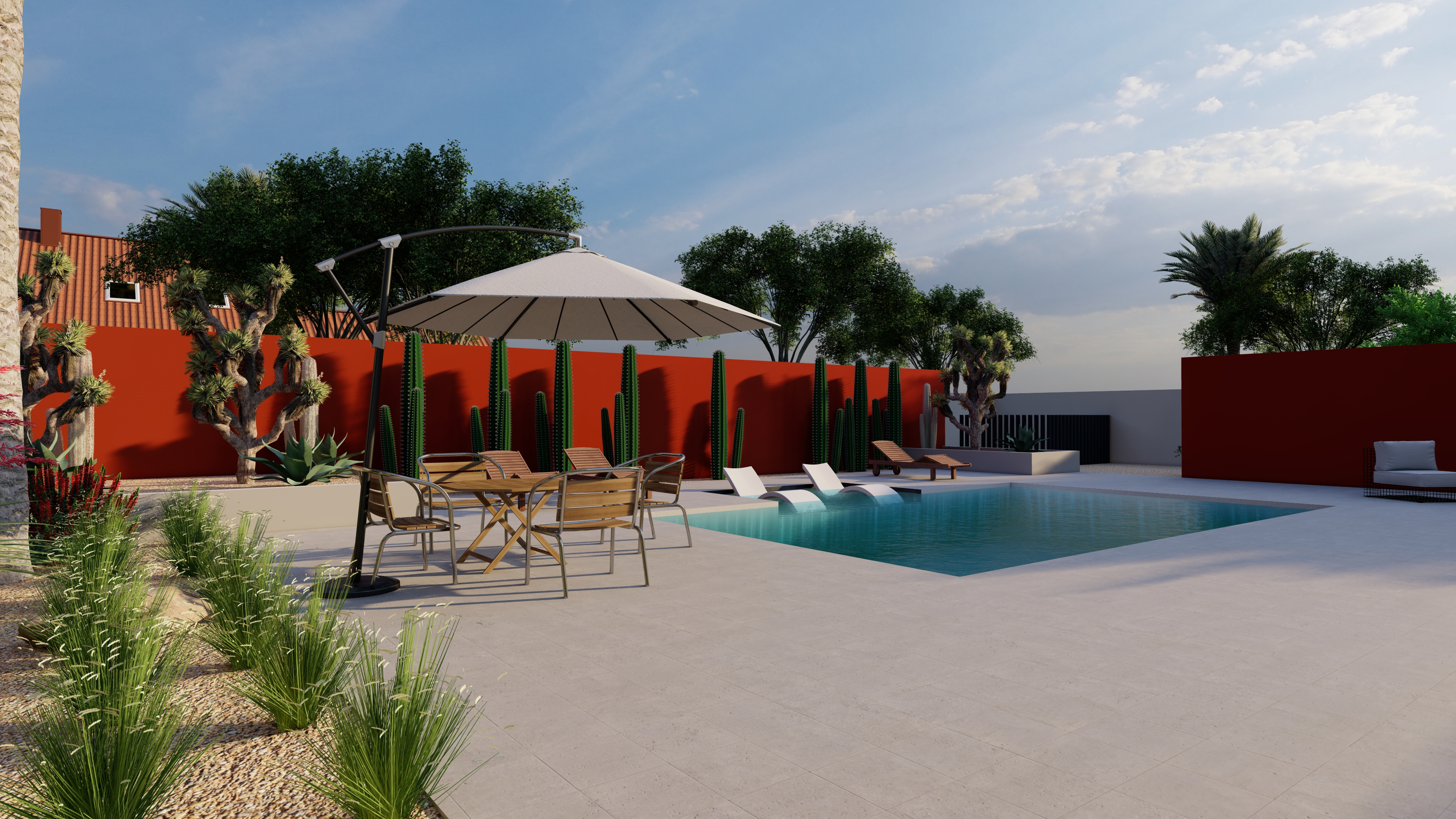
#9 // Create a Natural Desert Rock Garden
If you're searching for desert landscaping ideas, you don't have to look any farther than the surrounding landscape. There's a reason tourists come to visit the calming desert! Natural desert landscapes filled with sand, small rocks, and large boulders have their own unique look which is both organic and architectural.
Try creating a rock garden using stones of various colors, textures, and sizes for a visually appealing feature that doesn't require a drop of water. If you have a yard that came with large boulders, consider leaving those rocks right where they are as a natural focal point of your landscape. You can capture the look of a dry riverbed with tumbled river rocks and larger stones and plants along the "banks" to add an elegant touch of the wild into your yard.
And work with what you have. Have a great deck - add terracotta pottery or a nice water feature on it to help establish a look and feel.
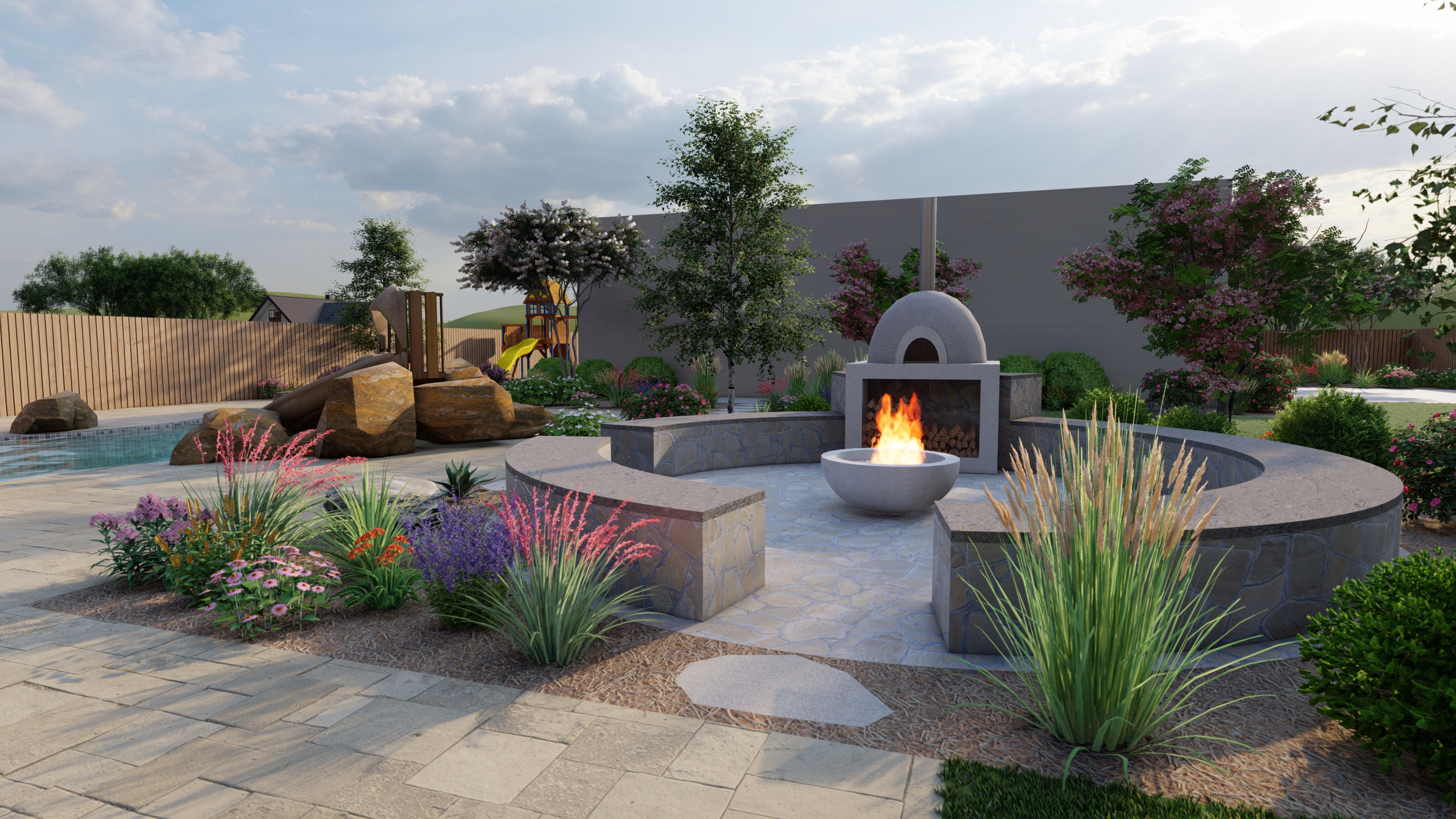
#10 // Add Height with Drought-Tolerant Trees
While tall cacti and low-growing succulents might dominate the world of desert garden ideas, trees can find themselves right at home in your landscape. Desert trees are uniquely hardy, tolerating intense daytime heat and nighttime cold as well as extended dry periods. The arid climate has shaped many of them into stunning architectural landscaping features that can become a showstopper in any yard.
Some desert-friendly trees include:
- Acacia
- Mesquite tree
- Ironwood
- Joshua tree
- Chaste tree
- Date palm
- Desert willow
Don't forget to consider native trees when making your selections! If you're lucky, you might already have a mature tree or two on your land that you can turn into a landscaping design feature.
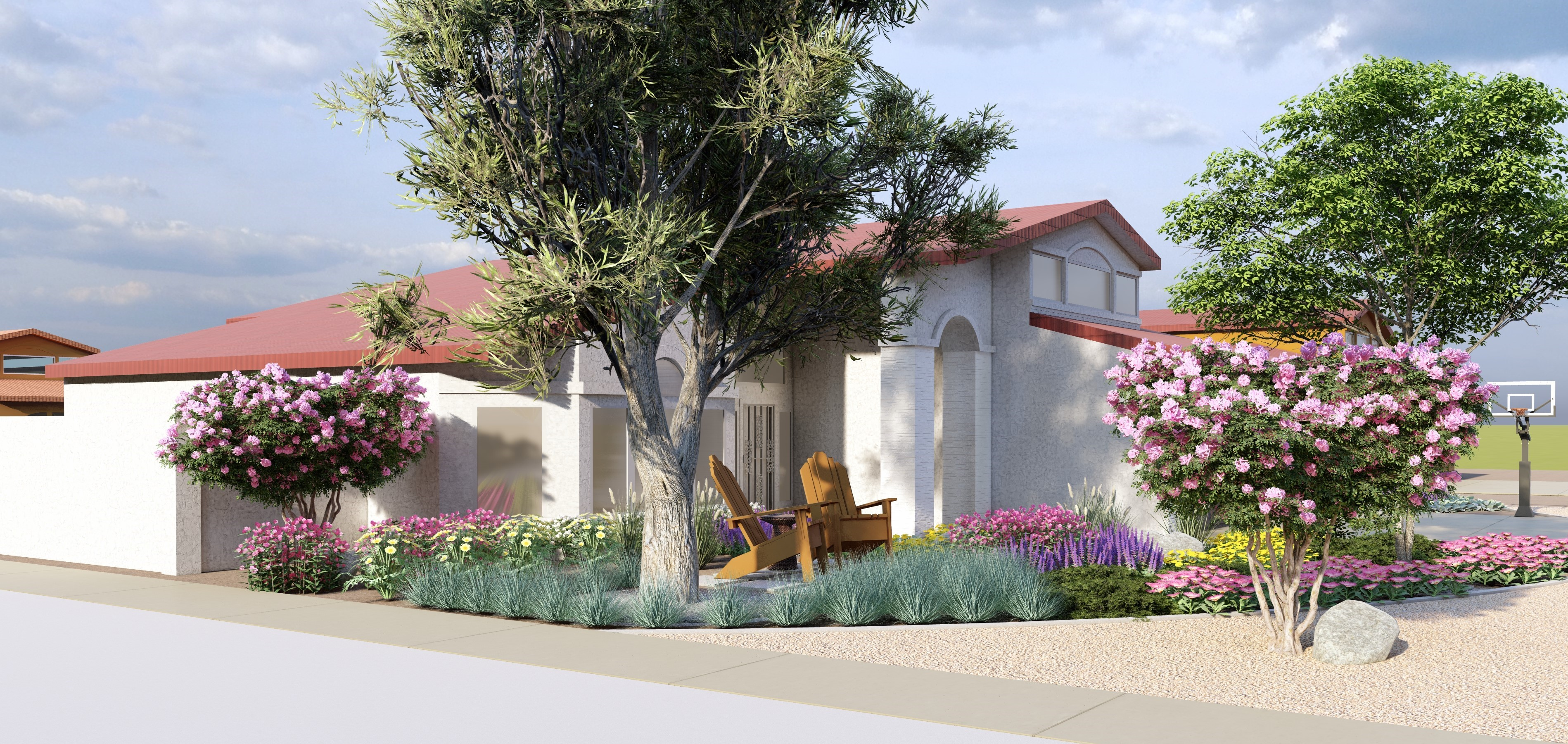
#11// Take Advantage of Gravel and Stone
The ideal affordable materials for a desert landscape might be hiding right under your nose. Our design team loves to use gravel and stone liberally throughout our desert landscaping to add curb appeal without breaking the bank.
There are countless places you can use stone and gravel in your yard. Stepping stones or soft decomposed granite can make an ideal pathway. Large stone pavers or pea gravel makes the perfect base for a patio. Gravel can even be used in place of mulch to fill in around trees and plants to keep the look of your desert garden cohesive.
Best of all, sourcing your rocks and gravel locally can help to lower costs and ensure that your materials look right at home in your desert landscape.
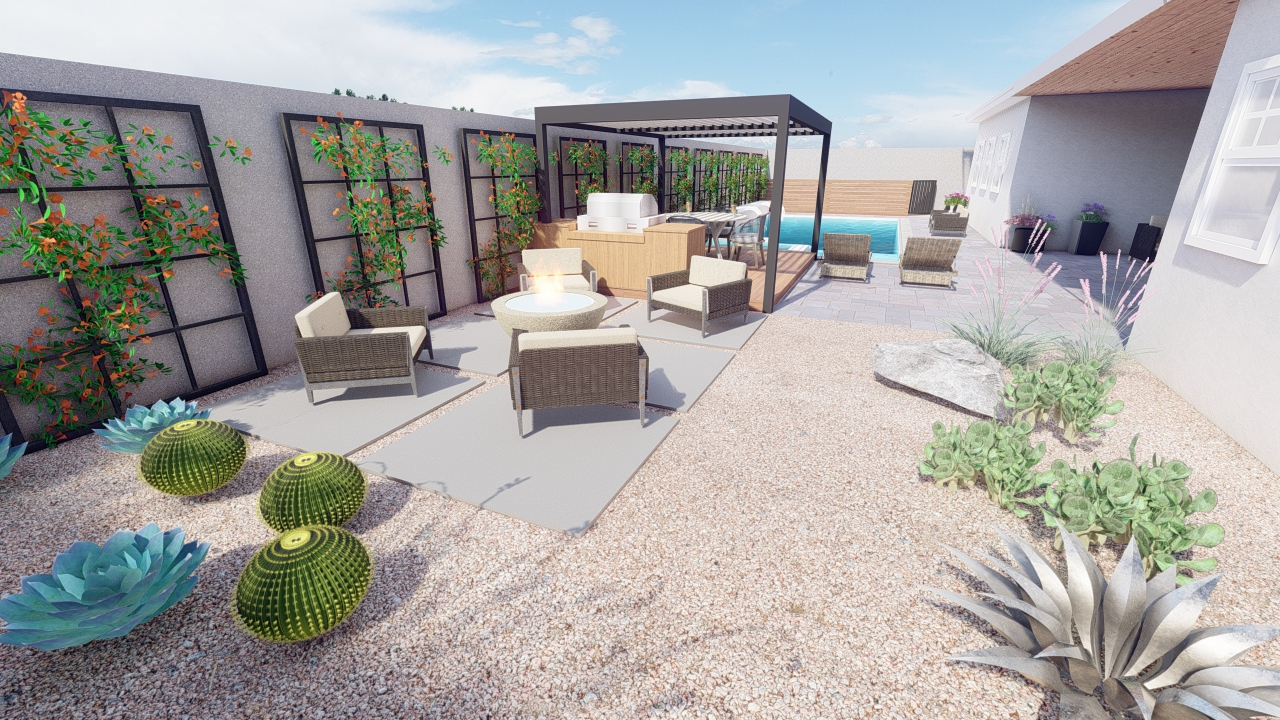
#12 // Incorporate Shaded Entertainment Areas
The sweltering heat and sun beating down can make it difficult to enjoy lunch on the patio when you live in a desert. An easy fix to make your backyard more livable is to add shaded areas to your yard.
A backyard pergola or pavilion is just the thing to add some welcome shade. A slatted pergola will create dappled shade, while a pavilion with a solid roof will offer more shelter for a patio dining area, outdoor kitchen or outdoor bar. A free-standing shade sail or an awning extending from the side of your home is another way to offer a little respite from the heat of the midday sun.
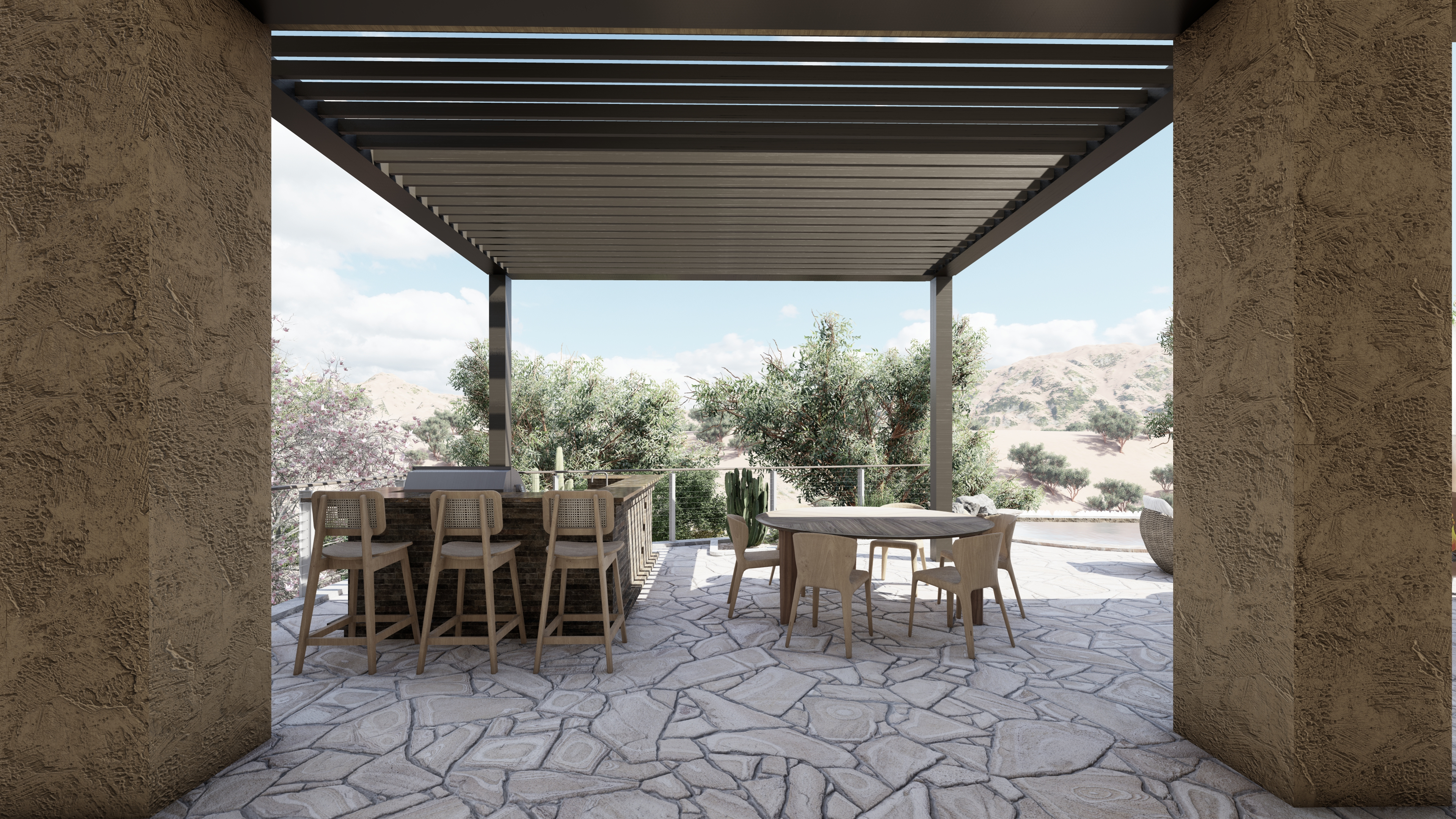
Designing for a desert landscape can be tricky, but the benefits are well worth it. Drought-tolerant landscaping can lower your water bill and even pay off with rebates and financial incentives in some areas! You can learn all about water-wise landscaping in our guide to xeriscaping and find more desert landscaping ideas in our portfolio of drought-tolerant landscape design.
This introduction to desert landscaping should provide plenty of inspiration to plant some desert flora in your garden beds or try your hand at a DIY project or two! If you want help from an expert landscape designer to plan your dream desert landscaping renovation, we've got you covered. Before long, you'll be able to swing open your back doors onto a rustic desert landscape brimming with cacti and wildflowers right in your backyard.
About Tilly
Tilly’s easy online landscape design process has been embraced by homeowners across the country and in Canada. Tilly breaks packages into the Front Yard, Backyard or your Full Yard. We match you with a professional landscape designer who is familiar with your region to create the perfect custom plan for your outdoor space.
To start our process you’ll fill out a questionnaire about your property that helps our design team understand your goals, needs and existing landscape. You can add 3d renders, lighting plans or side yards to your design package. You’ll then meet with your designer on a video call, show them your space and discuss your priorities.
Whether you are just looking to add some curb appeal or transform your entire backyard - we have a team for you!
Read more about: Landscape Design Tips, Sustainable Design